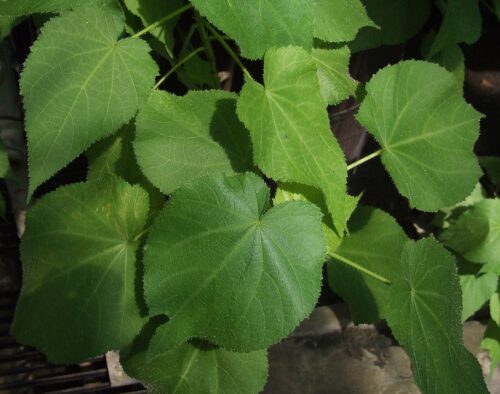African hemp is a plant in the mallow family and is native to open woodland in South Africa and Madagascar.
Also known as:
House lime
African linden
Cape Hollyhock
African hemp (Sparrmannia africana) is a plant in the mallow family (Malvaceae). African hemp is native to open woodlands in South Africa and Madagascar. In South Africa, the African hemp can grow three to six meter tall and + three meter wide. The evergreen shrub or small tree has distinctive large light green leaves up to 20 cm long and blooms with clusters of white flowers with red and yellow stamens.
As a houseplant in temperate regions, the African hemp blooms from September through April.
The stamens can move spontaneously when touched; this adaptation helps in more effective pollination.
Location: bright spot in a cool room: temperature between 12°C and 16°C. Not in drafts and not in direct sunlight. In the summer, the African hemp can be placed outside in a sheltered spot.
Soil: the chamber lime needs a lot of food: therefore mix potting soil with some clay or loam. Such a mixture also does not dry out quickly.
Repot: preferably every year, after flowering.
Watering winter: once or twice a week. Mix plant food (for green houseplants) with the watering water once a month.
Watering summer: once a week. Keep the soil moist, but not too wet. With an excess of water, the roots will rot and the room linden will die.
Pruning: top the shoots, this way the African hemp retains its shrub shape. Do this after flowering or in the spring.
Cuttings: Use the top shoots for cutting the chamber lime. Cuttings root easily, both in water and in potting soil mixed with some sand.
Bugs
When watering, small, black insects fly up: Sciara analis fly (Sciara analis). The adult mosquitoes do little harm. However, in a humid environment and at room temperature, mosquitoes thrive and female insects will lay eggs in the potting soil of houseplants. Between one hundred and two hundred eggs of + 0.2 mm in size are laid in groups near the roots. The larvae of the fern
Leaf turns yellow and bumpy; eggs on the underside of the leaf: glasshouse whitefly (Trialeurodes vaporariorum).
Dot-shaped spots on the leaves; mites on the underside: glasshouse red spider mite (Tetranychus urticae).
Fungi & diseases
The African hemp is not very susceptible to fungi and diseases.
Care
The African hemp regularly drops leaves: usually a lack of moisture, sometimes a lack of food and very occasionally a too low humidity in the (living) room is the cause.
Plant lets its leaves droop: water shortage.

